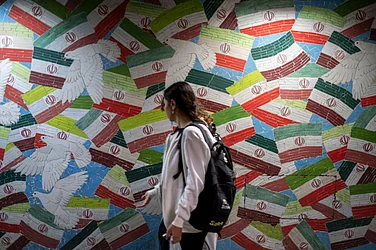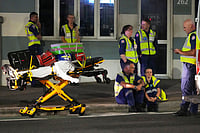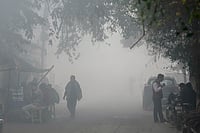The death toll of Turkey-Syria earthquake has reached 19,300. The 7.8-magnitude earthquake that struck the region on Monday was the strongest in decades.
The death toll is likely to rise as relief and rescue work goes on in the two affected countries. Moreover, the data from Syria is limited as there is no central authority in the country as the country is divided between government- and rebel-held territories.
Following the 7.8-magnitude earthquake, there were up to 2,000 aftershocks. Hours after the first earthquake, another quake struck more than 100 kilometers (60 miles) away with 7.5 magnitude.
Sebastien Gay, the head of mission in Syria for Doctors Without Borders, said health facilities in northern Syria were overwhelmed with medical personnel working around "around the clock to respond to the huge numbers of wounded".
This is the second major earthquake in Turkey in its recent past. In 199, around 18,000 were killed in similarly powerful earthquakes in northwest Turkiye.
Here we list 10 devastating natural disasters in the world in recent past:
Haiti earthquake, 2010
An earthquake 7-magnitude struck Haiti on January 12, 2010 and killed over 3 lakh people, according to official figures.
The initial quake was followed by a number of aftershocks, some of which were high on the richter scale. Densely-populated cities suffered major damage.
The Britannica Encyclopaedia noted, "The densely populated region around Port-au-Prince, located on the Gulf of Gonâve, was among those most heavily affected. Farther south the city of Jacmel also sustained significant damage, and to the west the city of Léogâne, even closer to the epicentre than Port-au-Prince, was essentially leveled."
One of the reasons for the widespread death toll was the weak infrastructure in the countru and lack of building regulations protecting against quakes.
"The collapsed buildings defining the landscape of the disaster area came as a consequence of Haiti’s lack of building codes. Without adequate reinforcement, the buildings disintegrated under the force of the quake, killing or trapping their occupants," says Britannica.
The Britannica further noted that around one-third of Haiti's population was affected by the 2010 earhquake and around 1 million were left homeless.
2004 Indian Ocean Tsunami, earthquake
The 2004 Indian Ocean Tsunami was triggered by a massive 9.1-magnitude undersea earthquake off the coast of Indonesia's Sumatra.
The Britannica Encyclopaedia says that at least 2,25,000 people across a dozen countries were killed and widespread damage was reported in a dozen countries, including Indonesia, Thailand, India, and Sri Lanka. The damage was reported in as far as coastal eastern Africa.
The Sumatra earthquake was the third-strongest of all time, according to the United States Geological Survey (USGS). The resultant tsunami is considered to be the deadliest ever.
Tsunamis are giant ocean waves that lash the shores with force. They are often triggered by earthquakes or volcanic eruptions. In the 2004 Indian Ocean Tsunami, waves as high as 30 feet lashed the shores.
Besides the immediate damage, the tsunami also led to food and water shortage as food supplies in the region were damaged and water was contaminated.
The Britannica notes, "The lack of food, clean water, and medical treatment—combined with the enormous task faced by relief workers trying to get supplies into some remote areas where roads had been destroyed or where civil war raged—extended the list of casualties. Long-term environmental damage was severe as well, with villages, tourist resorts, farmland, and fishing grounds demolished or inundated with debris, bodies, and plant-killing salt water."
Myanmar's Cyclone Nargis, 2008
The Cylone Nargis struck Myanmar in May 2008 and caused widespread damage to the country. The Britannica says it killed around 1,38,000 people.
The cyclonic winds were as high as 210 kilometers per hour (130 miles per hour), according to NASA's Earth Observatory.
The United Nations Economic Program (UNEP) called it Myanmar's worst natural disaster. It also devastated Myanmar's agriculture and ecology.
"Cyclone Nargis destroyed 38,000 hectares (ha) of natural and replanted mangroves, submerged over 63 percent of paddy fields and damaged 43 percent of freshwater ponds," notes UNEP. The UNEP also notes that human actions contributed to such increased damage.
It says, "The cyclone’s impacts were exacerbated by earlier damage to the environment, including deforestation and degradation of mangroves, over-exploitation of natural resources such as fisheries, and soil erosion. For example, the heavy loss of life as a result of the storm surge was primarily
due to prior loss of about 75 percent of the original mangrove cover in the Delta, which could have served as a buffer against the storm surge. The deterioration of the natural resource base, in effect, reduced people’s resilience against the impacts of Nargis."
Nepal earthquake, 2015
A 7.8-magnitude earthquake struck Nepal on April 25, 2015. It killed around 9,000 people and caused widespread damage, including to iconic heritage structures across the country.
Though Nepal had the worst impact, with around 6,000 structures damaged in capital Kathmandu alone, the impact was also felt in Northern India, Western Bhutan, and parts of Bangladesh.
The earthquake was worsened by massive aftershocks that were as strong as 7.3 on richter scale.
The Britannica notes, "Two large aftershocks, with magnitudes 6.6 and 6.7, shook the region within one day of the main quake, and several dozen smaller aftershocks occurred in the region during the succeeding days. On May 12 a magnitude-7.3 aftershock struck some 76 km (47 miles) east-northeast of Kathmandu, killing more than 100 people and injuring nearly 1,900."
The relief and rescue work was complicated by the tough mountaneous terrain of Nepal as a large part of the country is home to Himalayan ranges.
The UN said in a report that up to 8 million people were affected by the earthquake.
The relief work was further complicated by the evolving situation in Nepal. The Kathmandu airport could not bear the load of large aircraft carrying rescue personnel, equipment, and relief material, and tents and portable habitation on the roads and streets of people whose homes were damaged or destroyed affected the swift movement of trucks and convoys carrying personnel and supplies.
Kashmir earthquake, 2005
A 7.6-magniture earthquake struck the Jammu and Kashmir on October 8, 2005, leading to around 79,000 deaths.
The 2005 earthquake, often called the Kashmir earthquake, affected J&K, the Pakistan Occupied Jammu and Kashmir, Pakistan's Khyber Pakhtunkhwa province, and neighbouring Afghanistan's region. The epicenter of the quake was 19 kms northeast of Muzaffarabad in POJK.
Pakistan invaded Jammu and Kashmir in 1947 and India and Paksitan fought a war in 1947-48. Though Pakistan failed to capture the complete Kashmir Valley, it ended up controlling large chunks of the J&K state and continues its illegal occuption to this date. The illegally occupied parts of J&K are called Pakistan Occupied Jammu and Kashmir. This part bore the largest brunt of the earthquake.
The Britannica says, "The Muzaffarabad area was the worst hit, and a number of villages there were totally destroyed. At least 32,335 buildings collapsed in various cities in the Kashmir region—including Anantnag and Srinagar in Jammu and Kashmir state (now union territory), India—with additional property losses reported in the Pakistani cities of Islamabad, Lahore, and Gujrat, among others."
Japan earthquake and tsunami, 2011
Japan was hit by a 9.1-magnitude earthquake on March 11, 2011, which also triggered a tsunami that caused further damage.
The 2011 Japan earthquake was the strongest in Japan's history. It's also called the Tōhoku Earthquake as the epicentre was near Tohoku city.
The 2011 Japan earthquake was the third-strongest earthquake in world history, according to United States Geological Survey (USGS). Around 18-20,000 were killed in the earthquake and its powerful aftershocks. The damage was, however, very far-fetched as public infrastructure and homes were destroyed and a nuclear plant was also damaged, which put Japan on the verge of a nuclear disaster.
The Britannica says, "The tsunami raced outward from the epicentre at speeds that approached about 500 miles (800 km) per hour. It generated waves 11 to 12 feet (3.3 to 3.6 metres) high along the coasts of Kauai and Hawaii in the Hawaiian Islands chain and 5-foot (1.5-metre) waves along the island of Shemya in the Aleutian Islands chain."
At the Fukushima nuclear plant, tsunami water damaged the plant's generators and earthquake also caused damage, which resulted in partial meltdown. The nuclear material poured into Earth through containment vessels and there were also explosions after system failures, which led to fears of larger radiation exposure, leading to the area around the plant being turned into a containment zone.
The Britannica says, "The reactors at the three nuclear power plants closest to the quake’s epicentre were shut down automatically following the temblor...However, inundation by the tsunami waves damaged the backup generators at some of those plants, most notably at the Fukushima Daiichi (“Number One”)...With power gone, the cooling systems failed in three reactors within the first few days of the disaster, and their cores subsequently overheated, leading to partial meltdowns of the fuel rods. (Some plant workers, however, attributed at least one partial meltdown to coolant-pipe bursts caused by the earthquake’s ground vibrations.)
"Melted material fell to the bottom of the containment vessels in reactors 1 and 2 and burned sizable holes through the floor of each vessel, which partially exposed the nuclear material in the cores. Explosions resulting from the buildup of pressurized hydrogen gas in the outer containment buildings enclosing reactors 1, 2, and 3, along with a fire touched off by rising temperatures in spent fuel rods stored in reactor 4, led to the release of significant levels of radiation from the facility."
2013 Typhoon Haiyan
The 2013 Typhoon Haiyan struck East Asia in November 2013 and killed around 8,000 in the worst-hit Philippines.
Besides the Philippines, Palau, Vietnam, and China were also affected by the 2013 Typhoon Haiyan. The winds reached 314 kmph speed at landfall at peak.
Up to 4 million were displaced by the typhoon and several times more were affected in totality, according to official statements.
The Britannica notes, "By the end of the first week after the storm, the Philippine government was reporting that more than 800,000 people had been displaced and that some 8.7 million people were in some way affected by the storm. As relief work continued, however, the official numbers quickly rose to approximately 4 million displaced and in excess of 16 million overall affected. In addition, more than a million homes were reported to have been damaged, of which about half were completely destroyed."


























